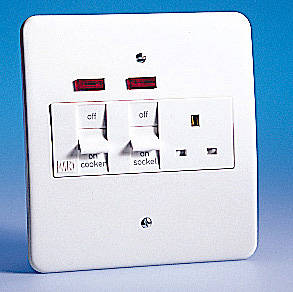The maximum supply to lighting is 16A, but in the main 6A because some thing on the circuit is likely only rated 6A, for example a ceiling rose used as a junction box, i.e. not end of the line.
We divide the supply into circuits for many reasons, one being so lights don't fail if there is a socket fault, bad enough some thing going wrong that gives you a shock, without also being plunged into darkness.
The ring final is often protected to 32A as is the cooker supply, and one needs to ensure any supply from these is unlikely to be overloaded.
So we are in essence looking at a risk assessment, and that is what the regulations do, so for example it thinks that fitting a fuse at destination rather than origin if the cable is unlikely to be physically damaged and less than 3 meters in length is an acceptable risk. And really that is what the regulations do, a panel of people look as accidents that have happened and work out what is an acceptable risk.
So take a real situation, an aerial feed wants splitting and boosting and you want leads as short as possible so location is loft, the booster splitter on sale local is built into a 13A plug, so since no 13A supply into loft using lighting supply would be easy way out, so we look at the risk, the main risk is some one unplugs the splitter booster and plugs in their drill instead, and this will likely over load the circuit and cause it to trip, and since the loft lights are on that circuit it means plunged into darkness, and since loft not fully floored the person could end up coming through the ceiling, but use a mast head amplifier instead and it can be powered from the coax cable, but they cost £80 instead of £20 for 13A splitter booster, so is it worth paying the extra? In real terms likely no, as you think your not daft enough to use a drill on a socket only put there to work the splitter, but there is clearly a risk, and you have to assess the risk.
So it is the same with what you ask, you consider what the risk is and assess it.
1. Can I power a kitchen hood/extractor via the lighting circuit directly? Or should I take power from an existing socket? (ring circuit)
I would say rule of thumb no load over 100W on a lighting circuit, so if a very light load as long as you can isolate it not really a problem, but since many hood/extractors also have lights, it would be an added safety feature if using a different supply to main lights so if they trip you still have light.
2. Should kitchen extractor be plugged into FCU? Or can I just wire a regular plug to the extractor?
Don't think it really matters electric wise, however easier to fit without having wires connected and then plug in, I have plug in ceiling roses so I don't need to hold weight of lights while wiring, trying to lean over the unit to wire is harder than simply plugging in.
3. I also need to create an additional socket for my fridge/Freezer. Can I take power from a cooker control switch which has an integrated socket? (as pictured)
Or would it be wise to spur of an existing socket in the ring circuit?
You can do either, which is most likely to trip, you clearly don't want to lose supply to freezer, so if the cooker with mineral insulated elements is likely to trip the RCBO rather than the ring final RCBO tripping then that may make one better then the other.
In general it is risk, cost, and ease and you take a balance, so if the lights are on the same RCD as the power, the idea of not using lighting circuit in case it causes it to trip does not really make much sense, but if all on their own RCBO then it does, also if the cooker is a 6 halogen ring with twin ovens adding the freezer may be the straw on camels back, but with a 4 ring induction and single oven unlikely to reach the maximum rating, so unlikely to be a problem.
With older houses the main problem is non RCD protected circuits, your not allowed any new socket without RCD protection, so where only some circuits are protected then this limits what you can do. I tend to think of my house, so 14 RCBO's so in my kitchen the lights on cooker extractor and counter are completely independent from ceiling lights, so if either trips others will work, that was not the case with my old house, two RCD's fed two fuse boxes with MCB's replacing the fuses, all original wiring on one, all new wiring on the other, so drop the kettle into the sink and lights would fail.
Rules wise to fit a socket in my kitchen either I need to register the work with LABC or use a scheme member electrician and in both cases all t need crossing and i dotted to get the completion or compliance certificate, it is not what makes sense, but how the person signing the paperwork views it. But unless your in Wales like me, use common sense.



